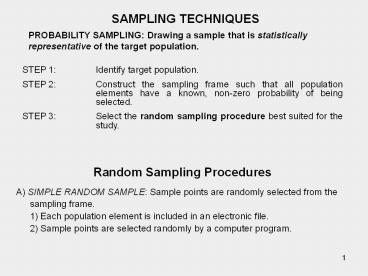SAMPLING TECHNIQUES PowerPoint PPT Presentation
1 / 7
Title: SAMPLING TECHNIQUES
1
SAMPLING TECHNIQUES
PROBABILITY SAMPLING Drawing a sample that is
statistically representative of the target
population.
STEP 1 Identify target population. STEP
2 Construct the sampling frame such that all
population elements have a known, non-zero
probability of being selected. STEP 3 Select the
random sampling procedure best suited for the
study.
Random Sampling Procedures
A) SIMPLE RANDOM SAMPLE Sample points are
randomly selected from the sampling frame. 1)
Each population element is included in an
electronic file. 2) Sample points are selected
randomly by a computer program.
2
Random Sampling Procedures
- B) SYSTEMATIC RANDOM SAMPLE Sample points are
spread over entire sampling frame. - Determine the sampling interval N/n
- where N population size
- n sample size
- e.g., N 8000 and n 200 ? N/n 8000/200 40
- 2) Determine one random number (k) in the first
interval. - e.g., k 12
- 3) The sample contains the kth element in each
sampling interval. - i.e., 1st interval ?12th element
- 2nd interval ?12 40 52nd element
- 3rd interval ?12 80 92nd element
- 4th interval ? 12 120 132nd element
- 200th interval ? 12 7960 7072nd element
3
Random Sampling Procedures
C) STRATIFIED RANDOM SAMPLE Sample points are
proportionally represented within population
subgroups. The subgroups are chosen with the
needs of the study in mind. e.g., N 8000 and n
200 Male 43 and Female 57 .43 x n
.43 x 200 86 males .57 x n .57 x 200
114 females n 200
4
Random Sampling Procedures
D) CLUSTER SAMPLING Sample points are all the
members of a naturally occurring unit
(cluster). 1) The target population is divided
into natural occurring subgroups
(clusters). e.g., UW-Ls 19 sports
clubs 2) Subgroups are randomly chosen. e.g.,
AIKIDO CLUB, CYCLING CLUB, EQUESTRIAN CLUB, RUGBY
CLUB (WOMEN'S), VOLLEYBALL CLUB (MEN'S)
3) Sample points are all elements in chosen
clusters.
5
SAMPLING TECHNIQUES
NON- PROBABILITY SAMPLING Drawing a sample of a
hard-to-identify group for which a sampling frame
is not available .
- CHUNK SAMPLING (INTERCEPT SURVEY) Go to the
location where you will find people who are
members of the hard-to-identify group. - JUDGMENT SAMPLING Hand pick the respondents.
- CONVENIENCE SAMPLING Survey anyone.
6
Non-Random Sampling Procedures
NOTES When a non-probability sampling procedure
is used 1) the reasons for choosing the
non-probability sampling procedure and the
limitations of the sampling procedure must be
explained in the report. 2) efforts to introduce
variation in the sampling procedure must be
explained in the report. 3) statistical
inferences can not be made unless the assumption
is made that the sample is random. This
assumption must be explained in the report.
7
Things You Should Know
- Exam 1 is on Monday/Tuesday of next week.
Information about exam 1 is on the web site in
Exam 1 Memo - Teams surveying UW-L students
- Submit your request for a sample to me in class
tomorrow. - Its time to learn about Select Survey
- You will be emailed your sample and Select Survey
login information later this week.

